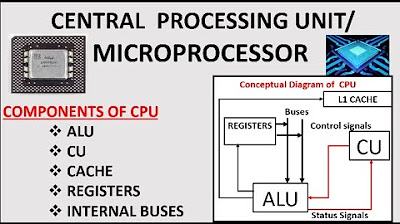Informatika kelas 9 Unit Pengolahan Logika dan Aritmatika
Summary
TLDRIn this educational video, the host explains the concept of the Arithmetic and Logic Unit (ALU) in computers, focusing on its critical role in performing arithmetic and logical operations within the CPU. The video covers the basic components of ALU, including the Arithmetic Unit and the Boolean Logic Unit, and explains their function in executing calculations like addition, subtraction, multiplication, and division. It also introduces key concepts such as half adders, full adders, and parallel adders, emphasizing their use in binary calculations. The host concludes by highlighting the importance of ALU's interaction with other components like the Control Unit and Registers in the CPU.
Takeaways
- 😀 The Arithmetic and Logic Unit (ALU) is a vital component in a computer, responsible for performing arithmetic and logical operations.
- 😀 ALU operates within the Central Processing Unit (CPU) and works alongside other components like RAM, VGA, and hard disk.
- 😀 ALU performs two main functions: arithmetic operations (addition, subtraction, etc.) and logical operations (comparisons such as 'greater than', 'less than').
- 😀 The ALU uses binary code to execute instructions and processes data with the help of registers that store intermediate results.
- 😀 The basic operations ALU handles include addition, subtraction, multiplication, and division.
- 😀 There are two main units within ALU: the Arithmetic Unit and the Boolean Logic Unit, each specialized in different tasks.
- 😀 Logic operations in ALU involve comparisons of two binary values, including equality, inequality, and relational operators like greater than or less than.
- 😀 The full adder and half adder circuits are essential in ALU for performing binary arithmetic operations.
- 😀 The ALU's parallel adder circuit allows multiple binary numbers to be added simultaneously, improving efficiency.
- 😀 ALU functions in coordination with the Control Unit (CU) and registers to process and store results of mathematical or logical operations.
- 😀 A malfunction in ALU or its components can cause a computer to halt or stop functioning properly, as ALU is integral to the CPU's operations.
Q & A
What is the main topic discussed in the video?
-The video discusses the Arithmetic and Logic Unit (ALU) in a computer system, explaining its functions, components, and importance in processing arithmetic and logical operations.
What is the function of the Arithmetic and Logic Unit (ALU)?
-The ALU is responsible for performing arithmetic and logical operations in a computer. It handles basic mathematical tasks like addition, subtraction, multiplication, and division, as well as logical operations such as comparisons and decisions based on logic.
What are the two main components that make up the ALU?
-The two main components of the ALU are the arithmetic unit and the boolean logic unit. The arithmetic unit handles calculations like addition and subtraction, while the boolean logic unit handles logical operations like comparisons and decisions.
How does the ALU perform its operations?
-The ALU uses binary code to execute its operations. It receives data from registers, processes it, and stores the results back in registers. It also uses basic logical gates such as AND, OR, and full adders to perform arithmetic calculations.
What is a half adder, and how does it work?
-A half adder is a simple circuit used to add two binary digits. It has two inputs (A and B) and produces two outputs: Sum and Carry. For example, if A = 0 and B = 1, the sum would be 1, and the carry would be 0.
What is the difference between a half adder and a full adder?
-A full adder is an extension of the half adder that can handle the carry-in from previous bits. It adds three binary digits (two inputs and a carry input) and produces two outputs: Sum and Carry. It is used for multi-bit binary addition.
What is a parallel adder, and how does it function?
-A parallel adder is a circuit that uses multiple full adders to perform the addition of multi-bit binary numbers. It processes bits simultaneously, starting from the least significant bit and carrying over the result to the next bit until all bits are added.
How does the ALU interact with other components in the CPU?
-The ALU works closely with the Control Unit (CU) and registers within the CPU. The CU sends instructions to the ALU, which performs the necessary operations. Afterward, the results are stored in registers or sent to other parts of the system for further processing.
What role do registers play in the ALU's operations?
-Registers are small, high-speed memory units that temporarily hold data during ALU operations. They store the input values for the ALU to process and hold the output results, ensuring that data is quickly accessible during calculations.
What would happen if the ALU malfunctioned in a computer system?
-If the ALU malfunctioned, the computer would be unable to perform basic arithmetic or logical operations, which would cause the system to fail in executing most tasks, making it impossible for the computer to function properly.
Outlines

このセクションは有料ユーザー限定です。 アクセスするには、アップグレードをお願いします。
今すぐアップグレードMindmap

このセクションは有料ユーザー限定です。 アクセスするには、アップグレードをお願いします。
今すぐアップグレードKeywords

このセクションは有料ユーザー限定です。 アクセスするには、アップグレードをお願いします。
今すぐアップグレードHighlights

このセクションは有料ユーザー限定です。 アクセスするには、アップグレードをお願いします。
今すぐアップグレードTranscripts

このセクションは有料ユーザー限定です。 アクセスするには、アップグレードをお願いします。
今すぐアップグレード5.0 / 5 (0 votes)






